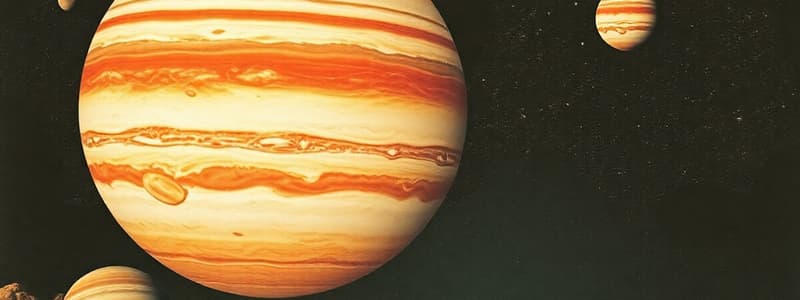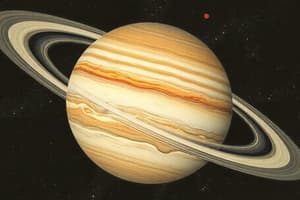Podcast
Questions and Answers
Which of the following is a primary component of Jupiter's atmosphere?
Which of the following is a primary component of Jupiter's atmosphere?
- Hydrogen gas (correct)
- Carbon dioxide
- Nitrogen gas
- Oxygen
What distinguishes Jupiter's rings from Saturn's rings?
What distinguishes Jupiter's rings from Saturn's rings?
- Jupiter's rings are much easier to see than Saturn's.
- Jupiter's rings are made up mostly of tiny bits of dust. (correct)
- Jupiter's rings are made of ice, while Saturn's are made of dust.
- Jupiter has significantly more rings than Saturn.
If a person weighs 100 pounds on Earth, approximately how much would they weigh on Jupiter?
If a person weighs 100 pounds on Earth, approximately how much would they weigh on Jupiter?
- 240 pounds (correct)
- 50 pounds
- 120 pounds
- 100 pounds
Which of Jupiter's moons is known for its numerous active volcanoes?
Which of Jupiter's moons is known for its numerous active volcanoes?
What is the primary mission of NASA's Juno spacecraft currently orbiting Jupiter?
What is the primary mission of NASA's Juno spacecraft currently orbiting Jupiter?
Which spacecraft first discovered Jupiter's rings in 1979?
Which spacecraft first discovered Jupiter's rings in 1979?
What is the significance of the moon Europa in the context of space exploration?
What is the significance of the moon Europa in the context of space exploration?
Approximately how many Earths could fit inside Jupiter?
Approximately how many Earths could fit inside Jupiter?
What is the defining characteristic of Jupiter's Great Red Spot?
What is the defining characteristic of Jupiter's Great Red Spot?
Which mission is scheduled to investigate Jupiter's icy moon Europa to determine whether there are places below the surface that could support life?
Which mission is scheduled to investigate Jupiter's icy moon Europa to determine whether there are places below the surface that could support life?
Which of Jupiter's moons is the largest in the solar system, even bigger than the planets Mercury and Pluto?
Which of Jupiter's moons is the largest in the solar system, even bigger than the planets Mercury and Pluto?
What is the approximate length of a day on Jupiter?
What is the approximate length of a day on Jupiter?
What two moons orbit within Jupiter's main ring and are thought to be the source of the ring's dust?
What two moons orbit within Jupiter's main ring and are thought to be the source of the ring's dust?
Which spacecraft used Jupiter's gravity to slingshot towards its ultimate destination, Saturn?
Which spacecraft used Jupiter's gravity to slingshot towards its ultimate destination, Saturn?
What is the composition of the yellow-orange surface of Jupiter's moon Io?
What is the composition of the yellow-orange surface of Jupiter's moon Io?
The Voyager 2 spacecraft is unique because it is the only spacecraft to have done what?
The Voyager 2 spacecraft is unique because it is the only spacecraft to have done what?
Which of Jupiter's ring is the faintest, widest doughnut-shaped ring, and is the closest to Jupiter?
Which of Jupiter's ring is the faintest, widest doughnut-shaped ring, and is the closest to Jupiter?
Which of the following spacecraft was deliberately destroyed in Jupiter's crushing atmosphere to protect a possible ocean beneath an icy crust on the moon Europa?
Which of the following spacecraft was deliberately destroyed in Jupiter's crushing atmosphere to protect a possible ocean beneath an icy crust on the moon Europa?
Approximately how long does it take sunlight to travel from the Sun to Jupiter?
Approximately how long does it take sunlight to travel from the Sun to Jupiter?
What is NASA's current mission to Jupiter called?
What is NASA's current mission to Jupiter called?
Flashcards
What is Jupiter?
What is Jupiter?
A gas giant and the fifth planet from our Sun, known for its Great Red Spot.
What is Jupiter's Great Red Spot?
What is Jupiter's Great Red Spot?
A centuries-old giant storm on Jupiter, bigger than Earth.
What is the Halo ring?
What is the Halo ring?
A faint, wide doughnut-shaped ring closest to Jupiter.
What is the Main ring?
What is the Main ring?
Signup and view all the flashcards
What are the Gossamer rings?
What are the Gossamer rings?
Signup and view all the flashcards
How fast does Jupiter rotate?
How fast does Jupiter rotate?
Signup and view all the flashcards
What is Ganymede?
What is Ganymede?
Signup and view all the flashcards
What is Callisto?
What is Callisto?
Signup and view all the flashcards
What is Io?
What is Io?
Signup and view all the flashcards
What is Europa?
What is Europa?
Signup and view all the flashcards
What is Pioneer 10?
What is Pioneer 10?
Signup and view all the flashcards
What is Pioneer 11?
What is Pioneer 11?
Signup and view all the flashcards
What is Voyager 1?
What is Voyager 1?
Signup and view all the flashcards
What is Voyager 2?
What is Voyager 2?
Signup and view all the flashcards
What is Galileo?
What is Galileo?
Signup and view all the flashcards
What is Cassini?
What is Cassini?
Signup and view all the flashcards
What is Juno?
What is Juno?
Signup and view all the flashcards
What is Europa Clipper?
What is Europa Clipper?
Signup and view all the flashcards
Study Notes
Overview of Jupiter
- Jupiter, the fifth planet from the Sun, is a gas giant.
- Over 1,300 Earths could fit inside Jupiter.
- Named after the king of the ancient Roman gods.
- The atmosphere mainly consists of hydrogen and helium, similar to the sun.
- It features a very thick atmosphere.
- The planet is covered in thick red, brown, yellow, and white clouds, creating a striped appearance.
- Sunlight takes 43 minutes to reach Jupiter from the Sun.
Jupiter's Great Red Spot and Winds
- The Great Red Spot is a centuries-old storm larger than Earth.
- Jupiter experiences very high winds, exceeding 400 mph, surpassing the speed of hurricanes and tornadoes.
- About 3 1/2 Earths could fit across this storm.
Jupiter's Rings
- Jupiter possesses three thin rings, unlike Saturn's.
- These rings are difficult to observe.
- Voyager 1 discovered the rings in 1979.
- The rings primarily comprise tiny dust particles.
- Halo: A faint, wide, doughnut-shaped ring closest to Jupiter
- Main Ring: Extends from the halo ring, with the moons Adrastea and Metis orbiting within, believed to be the dust source.
- Gossamer Rings: Very faint and wide, made of microscopic debris from Amalthea and Thebe, extending beyond Amalthea's orbit.
Rotation, Orbit, and Gravity
- Jupiter has the fastest rotation of any planet.
- A rotation takes only about 10 hours.
- Jupiter takes 12 Earth years to orbit the sun, thus one year on Jupiter is equivalent to 12 Earth years.
- Jupiter is very cold and has a stronger gravitational pull compared to Earth.
- A 100-pound person on Earth would weigh 240 pounds on Jupiter.
Jupiter's Major Moons
- Jupiter has four major moons: Ganymede, Callisto, Io, and Europa.
- Ganymede: Jupiter's largest moon is also the solar system's largest and bigger than Mercury and Pluto.
- Callisto: Heavily cratered surface.
- Io: Volcanically active moon producing sulfur gases, giving it a yellow-orange surface.
- Europa: Covered in water ice with a possible ocean or slushy ice beneath, potentially holding twice as much water as Earth.
Jupiter Exploration
- NASA astronomers have studied Jupiter using Earth-based telescopes and orbiting telescopes like the Hubble Space Telescope.
- Several NASA spacecraft explored Jupiter from 1979 to 2007, and beyond.
- Pioneer 10: The first spacecraft to visit the outer planets, launched in March 1972, made its closest approach to Jupiter on December 4, 1973, sending its last signal in January 2003 from 7.6 billion miles away.
- Pioneer 11: Sister spacecraft to Pioneer 10, flew closer to Jupiter in 1974 en route to Saturn and studied Saturn's rings.
- Voyager 1: Discovered a thin ring, Thebe and Metis, and active volcanoes on Io during its Jupiter flyby in March 1979.
- Voyager 2: The sole spacecraft to study all four giant planets, it discovered Jupiter's 14th moon.
- Galileo: The first spacecraft to orbit an outer planet, launching in 1989 and orbiting Jupiter for around eight years to study and send a probe into the atmosphere of Jupiter, before being destroyed to protect one of its key discoveries - water on Europa.
- Cassini: Explored the Jupiter system for six months, from October 2000 to March 2001, while en route to Saturn, using Jupiter's gravity for a slingshot effect.
- Juno: Launched in 2011 and arrived in 2016, Juno orbits Jupiter to study its formation, origin, evolution, moons, rings, and environment until September 2025
- Juno is named after Jupiter's wife, who could see through his tricks and clouds.
- Europa Clipper: Launched in October 2024 and expected to reach Jupiter in 2030, it will conduct multiple flybys of Jupiter's moon Europa to assess its habitability.
Studying That Suits You
Use AI to generate personalized quizzes and flashcards to suit your learning preferences.



